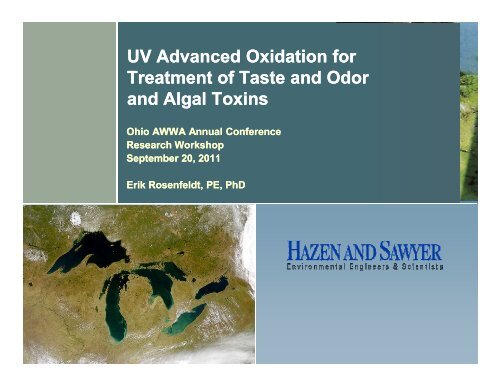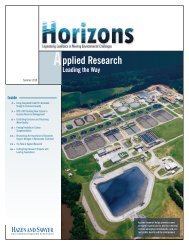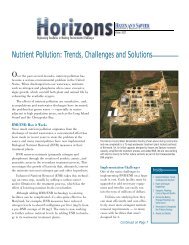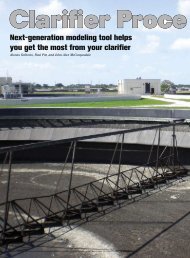Presentation - Hazen and Sawyer
Presentation - Hazen and Sawyer
Presentation - Hazen and Sawyer
Create successful ePaper yourself
Turn your PDF publications into a flip-book with our unique Google optimized e-Paper software.
UV Advanced Oxidation for<br />
Treatment of Taste <strong>and</strong> Odor<br />
<strong>and</strong> Algal Toxins<br />
Ohio AWWA Annual Conference<br />
Research Workshop<br />
September 20, 2011<br />
Erik Rosenfeldt, PE, PhD
2<br />
<strong>Presentation</strong> Agenda<br />
• Algae issues<br />
Taste <strong>and</strong> Odor<br />
Toxic Substances<br />
• Climate change impacts on algae events<br />
• UV Advanced Oxidation<br />
Fundamentals<br />
Treatment of taste <strong>and</strong> odor, toxins<br />
Comparisons with other technologies<br />
• Summary <strong>and</strong> Conclusions
3<br />
Algae Issues<br />
• Seasonal algae blooms present many problems<br />
for water utilities<br />
Depleted oxygen<br />
Turbidity<br />
Taste <strong>and</strong> Odor<br />
• Cyanobacteria<br />
“Blue-green” algae<br />
Not quite algae, not quite bacteria<br />
• Photosynthetic but lack well-defined nucleus<br />
Responsible for Taste <strong>and</strong> Odor compounds<br />
Create <strong>and</strong> may release toxic compounds
4<br />
Algal Taste <strong>and</strong> Odor Compounds<br />
• Methylisoborneol (MIB) <strong>and</strong> geosmin<br />
Musty/earthy odor detectable at low (5-10 ng/L levels)<br />
Non-toxic<br />
Released by cyanobacteria<br />
Not regulated, but public perception rules
Cyanotoxins<br />
5<br />
• Some blue-green can produce one or more toxins<br />
Do not produce toxins at all times<br />
• Toxins can affect<br />
Fish <strong>and</strong> other aquatic life<br />
Livestock<br />
Pets<br />
Humans<br />
• Exposure routes in humans<br />
Dermal<br />
Oral (water or food)<br />
Inhalation<br />
Dialysis<br />
• Included on US EPAs CCL3
6<br />
Cyanotoxins<br />
Species<br />
Aphanacapsa spp.<br />
Dermatoxin<br />
(Irritant)<br />
Hepatoxin (Liver)<br />
microcystins<br />
Neurotoxin<br />
(Nervous)<br />
Microcystis spp. microcystins, nodularin anatoxins<br />
Snowella spp.<br />
microcystins<br />
Taste/Odor<br />
Compound<br />
Synechococcus spp. microcystins MIB, Geosmin<br />
Woronichinia spp.<br />
microcystins<br />
Lyngbya spp. Lyngbyatoxins saxitoxins MIB<br />
Oscillatoria spp. Aplysiatoxins microcystins<br />
anatoxins,<br />
saxitoxins<br />
MIB, Geosmin<br />
Planktothrix agardhii Aplysiatoxins microcystins saxitoxins MIB, Geosmin<br />
Pseudoanabaena spp.<br />
Anabaena spp.<br />
Anabaenopsis elenkii<br />
Aphanizomenon spp.<br />
Cylindrospermopsis<br />
raciborskii<br />
Nordularia spp.<br />
microcystins,<br />
cylindrospermopsin<br />
microcystins<br />
microcystins,<br />
cylindrospermopsin<br />
cylindrospermopsin<br />
microcystins, nodularin<br />
anatoxins,<br />
saxitoxins<br />
anatoxins,<br />
saxitoxins<br />
saxitoxins<br />
MIB, Geosmin<br />
MIB, Geosmin<br />
Geosmin<br />
Tedesco et al, 2011
Cyanotoxin Occurrence<br />
7<br />
Indiana data<br />
• Yearly occurrence<br />
• Occurs during algal<br />
blooms<br />
Late summer, early fall<br />
• Toxins typically released<br />
during lysis<br />
Algae mitigation processes<br />
can make problem worse<br />
Tedesco et al, 2011
Cyanotoxins in Ohio<br />
8<br />
• Lake Erie <strong>and</strong> Gr<strong>and</strong> Lake<br />
St. Marys Algal Blooms<br />
• Last year: Ohio EPA testing<br />
revealed 0.23 <strong>and</strong> 0.16 ppb<br />
Microcystin in two treated<br />
drinking waters<br />
Lake Erie Source:<br />
• Potassium Permanganate, PAC, Lime Softening,<br />
Filtration, Chlorine<br />
Lake Erie Source:<br />
• Raw water filtration, Ozone, adsorption clarifier,<br />
chlorine disinfection
Cyanotoxins <strong>and</strong> Taste <strong>and</strong> Odor<br />
9<br />
• USGS 2010 study (ES&T<br />
44, 7361 – 7368)<br />
• Sampled 23 Midwest lakes<br />
Multiple toxin classes cooccurred<br />
in 48%<br />
Toxins <strong>and</strong> T&O co-occurred<br />
in 91%<br />
• No health risks during T&O<br />
outbreaks?
Climate Impacts on Algae<br />
10<br />
• Temperature<br />
Warmer temperatures encourage blooms (Pearl <strong>and</strong><br />
Huisman, 2008)<br />
Warmer temperatures increase the odor intensity of VOCs at<br />
very low concentrations, increasing consumer detection<br />
(Whelton et al., 2004)<br />
• Precipitation<br />
Long antecedent dry periods increase nutrient content of<br />
runoff<br />
Low rainfall can cause stagnant conditions in the watershed<br />
• Wind/storms<br />
Heavy storms <strong>and</strong> strong wind can mix reservoirs,<br />
reintroducing nutrients into the water column from bottom<br />
sediments
Northeast Climate Projections<br />
11<br />
• Temperature<br />
3° to 7°C temperature increase by<br />
2100 (Frumhoff et al, 2007)<br />
More frequent days over 35°C<br />
(Karl et al, 2009)<br />
• Precipitation<br />
5 to 10% increase, mostly in fall<br />
<strong>and</strong> winter (Frumhoff et al, 2007)<br />
• Storms<br />
Increasing trends in extreme<br />
precipitation (Spierre <strong>and</strong> Wake,<br />
2010)
What will OH’s climate look like?<br />
12<br />
Lower Emissions Scenario<br />
Higher Emissions Scenario<br />
2010 - 2039<br />
2040 - 2069<br />
2070 - 2090<br />
2010 - 2039<br />
2040 - 2069<br />
2070 - 2090<br />
Adapted from Frumhoff et al, 2007
13<br />
What can be done?<br />
• Algae blooms are getting more prevalent <strong>and</strong><br />
potentially more dangerous<br />
• Fortunately, algae typically only occur in the<br />
summer months<br />
• Several treatment processes are effective<br />
Activated Carbon<br />
• GAC<br />
• PAC<br />
Ozone<br />
UV Advanced Oxidation (UV AOP)
Advanced Oxidation Processes<br />
14<br />
■<br />
■<br />
■<br />
■<br />
■<br />
■<br />
An effective process for disinfection <strong>and</strong><br />
chemical oxidation, capable of providing<br />
barriers for protecting public health <strong>and</strong><br />
improving public perception<br />
– Pharmaceuticals, Personal Care Products, EDCs<br />
– Crypto, Viruses, E. coli, etc.<br />
AOPs work by creating hydroxyl radicals (•OH)<br />
– •OH then blast away at organic chemicals<br />
Usually an expensive chemical process<br />
Complex chemistry<br />
UV Based AOPs<br />
■<br />
UV/H 2 O 2 , UV/O 3 , UV/HOCl, etc.<br />
Ozone Based AOPs<br />
■<br />
Ozone/H 2 O 2 , Ozone/NOM, Ozone/pH
15<br />
UV/H 2 O 2 AOP<br />
• H 2 O 2 absorbs UV energy <strong>and</strong><br />
degrades to 2 OH radicals<br />
• Only 1 OH radical per UV<br />
photon<br />
• Due to “water caging”<br />
Org<br />
•OH<br />
H 2 O 2<br />
•OH<br />
UV Absorbance of H 2 O 2<br />
ε (M -1 cm -1 )<br />
250<br />
200<br />
150<br />
100<br />
50<br />
0<br />
200 220 240 260 280 300<br />
Wavelength (nm)<br />
Org<br />
H 2 O<br />
H 2 O 2 •OH •OH<br />
H 2 O 2<br />
H 2 O
Fundamentals – UV/H 2 O 2<br />
AOP<br />
16<br />
• AOP High powered<br />
oxidation of<br />
contaminants via OH<br />
radical intermediate<br />
OH radical is very<br />
reactive with “targets”<br />
OH radical is also<br />
reactive with<br />
“scavengers”<br />
Pollutant or<br />
Constituent<br />
OH radical rate<br />
constant (M -1 s -<br />
1<br />
)<br />
Reference<br />
MTBE<br />
Atrazine<br />
NDMA<br />
MIB<br />
Geosmin<br />
Bisphenol-A<br />
1.9x10 9<br />
3x10 9<br />
3.3x10 9<br />
8.2x10 9<br />
1.4x10 10<br />
1.02x10 10 Acero et al., 2001<br />
Acero et al., 2000<br />
Wink <strong>and</strong> Desrosiers, 1991<br />
Glaze et al., 1990<br />
Glaze et al., 1990<br />
Rosenfeldt <strong>and</strong> Linden, 2004<br />
17-β-Estradiolβ<br />
1.41x10 10 Rosenfeldt <strong>and</strong> Linden, 2004<br />
H 2 O 2 2.7x10 7 1988<br />
17-α-Ethinyl Estradiol 1.08x10 10 Rosenfeldt <strong>and</strong> Linden, 2004<br />
4-Nonylphenol<br />
5.65x10 9<br />
AWARF, 2006<br />
Para-Chlorobenzoic<br />
5x10 9<br />
Elovitz <strong>and</strong> von Gunten, 1999<br />
Acid<br />
3.9x10 9<br />
Buston et al., 1988<br />
Nitrobenzene<br />
9.7x10 9<br />
Buxton et al., 1988<br />
Methanol<br />
2.5x10 4 (L mg -1 s - Larson <strong>and</strong> Zepp, 1988<br />
NOM (TOC)<br />
1<br />
)<br />
Hoigne et al., 1985; Buxton et al,<br />
HCO<br />
-<br />
3 8.5x10 6<br />
1988<br />
CO<br />
-2<br />
3 3.9x10 8 Hoigne et al., 1985; Buxton et al.,<br />
Buxton et al., 1988
Differences between UV<br />
disinfection <strong>and</strong> AOP<br />
• Some fundamental differences in<br />
Levels of Applied UV Energy<br />
Fundamental Mechanisms<br />
UV Dose (ie what does it mean?)<br />
• Different “Targets”<br />
17<br />
Disinfection Photolysis AOP
UV AOP for Taste <strong>and</strong> Odor<br />
18<br />
UV Photolysis<br />
UV Advanced Oxidation<br />
Rosenfeldt <strong>and</strong> Linden, 2005<br />
UV Advanced Oxidation<br />
for Geosmin Oxidation<br />
at Cornwall, ON<br />
TrojanUV, 2010
UV AOP for Algal Toxins<br />
UV <strong>and</strong> UV AOP for m-LR destruction<br />
UV AOP for MIB <strong>and</strong> algal toxins at<br />
Cornwall, ON<br />
19<br />
Approximate<br />
Geosmin<br />
removal<br />
Alvarez et al, 2010<br />
UV <strong>and</strong> UV AOP for m-RR destruction<br />
TrojanUV, 2010<br />
Qiao et al, 2005
Taste <strong>and</strong> Odor as a surrogate for toxin<br />
oxidation?<br />
20<br />
• Characteristics of a good surrogate<br />
Co-occurrence (Graham et al, 2010)<br />
• Microcystin co-occurred with geosmin in 87% of blooms, with MIB<br />
in 39%.<br />
• Anatoxin-a co-occurred with geosmin in 100% of blooms, with MIB<br />
in 43%.<br />
Similar trends of occurrence (Graham et al, 2010)<br />
• Although toxins <strong>and</strong> T&O frequently co-occurred, concentrations<br />
were not strongly correlated (r < 0.4, p > 0.1)<br />
• Not surprising because they are not produced by the same<br />
biochemical pathways<br />
Surrogate is conservative<br />
• Microcystin LR <strong>and</strong> Anatoxin degraded faster than MIB, but not<br />
geosmin
Why UV AOP makes some sense<br />
21<br />
• “Instant-on” technology<br />
• Effective Disinfection / Innovative Technology<br />
• Comparable replacement for other T&O treatment<br />
processes<br />
Pantin, 2009
Why UV AOP makes some sense<br />
Cornwall, ON<br />
• Trojan UV Swift TM ECT Reactors (MP technology)<br />
UV system serves in disinfection mode” most of the year (4 of 8 lamps<br />
running)<br />
Can “ramp-up” to AOP conditions seasonally (8 lamps running, add H 2 O 2 )<br />
22<br />
• 5 operational levels UV dose ~ 400 – 60 mJ/cm<br />
2<br />
– H 2 O 2 varies 1, 2, 4, 8, 15 mg/L<br />
UV AOP replaces GAC filter<br />
caps for T&O control<br />
($100,000/yr for GAC<br />
replacement).<br />
UV provides excellent<br />
disinfection barrier<br />
Pantin, 2009
Why UV AOP makes some sense<br />
23<br />
Neshaminy Water Treatment Plant<br />
Civardi <strong>and</strong> Lucca, 2010 (OAWWA <strong>and</strong> Tricon) compared<br />
costs <strong>and</strong> carbon footprint for 20 year design life<br />
• 15 MGD Plant, Desired 1 log removal of “Geosmin <strong>and</strong> MIB”<br />
• Assume 90 days per year of use (each is “instant-on”)<br />
UV-H 2 O 2 AOP<br />
PAC<br />
Capital $2.5 mil $2.2 mil<br />
O&M $200,000 $310,000<br />
Equivalent Uniform<br />
Annual Cost (4%)<br />
$384,000 $475,000<br />
Civardi <strong>and</strong> Lucca, 2010
24<br />
Why UV AOP makes some sense<br />
• Byproducts?<br />
In most cases, this is a major impact on AOP feasibility<br />
• Eg: Estrogenic activity of BPA goes away slower than BPA<br />
H 3 C<br />
CH 3<br />
HO<br />
OH<br />
BPA
Byproducts<br />
25<br />
• In the case of UV AOP treatment of taste <strong>and</strong> odor <strong>and</strong><br />
toxins, the story is simpler…<br />
Taste <strong>and</strong> odor <strong>and</strong> toxic action are very dependent on molecular<br />
structure<br />
Small changes in structure (ie oxidation, phototransformation, etc.)<br />
will likely diminish toxicity significantly<br />
Anatoxin-a<br />
250 µg/kg<br />
Anatoxin-a(S)<br />
20 µg/kg<br />
MIB<br />
No toxicity
Wrap Up<br />
26<br />
• Algal toxins <strong>and</strong> algae related taste <strong>and</strong> odor<br />
outbreaks are both caused by seasonal,<br />
cyanobacteria outbreaks<br />
• Recent research has indicated that presence of<br />
taste <strong>and</strong> odor (geosmin particularly), correlates<br />
well with presence of algal toxins<br />
• UV Advanced Oxidation effectively degrades both<br />
T&O <strong>and</strong> algal toxins<br />
In general, MIB < Geosmin ~ Anatoxin
Parting thought…<br />
27<br />
“Drinking water purveyors frequently tell customers<br />
during taste-<strong>and</strong>-odor outbreaks that there are no<br />
health risks. In our study, however, taste-<strong>and</strong>-odor<br />
causing compounds were always accompanied by<br />
cyanotoxins, highlighting the need for water<br />
purveyors to increase cyanotoxin surveillance during<br />
taste-<strong>and</strong>-odor outbreaks so that treatment can be<br />
modified accordingly, <strong>and</strong> to verify that cyanotoxins<br />
are not present at or above thresholds of potential<br />
health risk.”<br />
Graham et al, 2010
28<br />
Questions?<br />
Erik Rosenfeldt, P.E., PhD<br />
<strong>Hazen</strong> & <strong>Sawyer</strong> Fairfax<br />
703-537-7920<br />
571-505-6601<br />
erosenfeldt@hazen<strong>and</strong>sawyer.com








